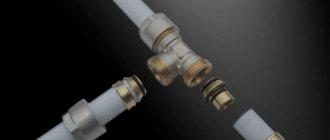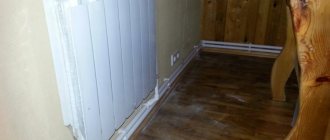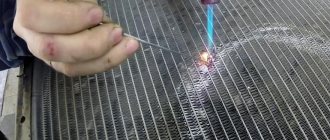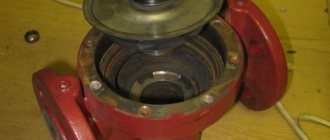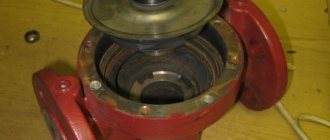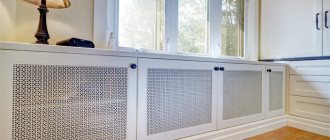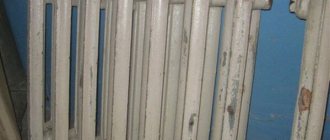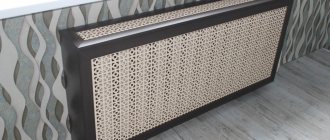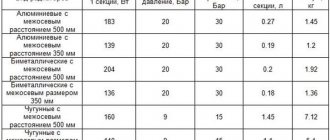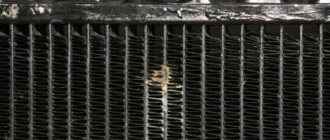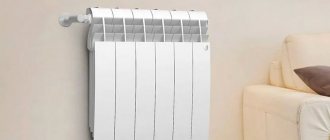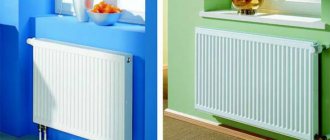Causes of damage to aluminum radiators
Aluminum radiators are not durable compared to bimetallic and cast iron ones. In apartment buildings, they most often leak due to pressure drops in the system and water hammer.
Changes in water or coolant temperature also affect the condition of the batteries. If a liquid hotter than 100 degrees circulates in the heating system, it can damage the gaskets and sealant.
When water or coolant boils, the pressure in the central heating system (central heating system) can rise significantly. This often results in damaged sections. In some cases, an aluminum radiator may simply burst.
Sometimes problems are due to incorrect installation. Moreover, an aluminum radiator can leak several years after installation. In this case, you can only rely on yourself and hope that the other batteries were connected correctly without violating the installation standards.
If you have cheap aluminum batteries installed, there is a risk of manufacturing defects. No one is immune from this and it cannot be determined in advance. Therefore, before you buy a radiator, think about it: isn’t it easier to pay a little extra and buy a good battery than to fix problems?
The battery is leaking
By the way, if a cast iron battery leaks, “what should I do? " - don't ask! You can’t get by with Masticos alone! At the end of the heating season, you will still have to call a welder and thoroughly weld cracks, fistulas, and other leakage factors! Mastix is a temporary solution!
It’s worse if the aluminum battery leaks due to hard water. Hard water destroys the protective coating of the channels for the passage of coolant inside aluminum batteries, after which the destruction of the aluminum itself begins.
Locate the leak
When an aluminum radiator leaks, the most difficult thing is to determine the location of the damage. Believe me, it's not as easy as it seems.
When you see a puddle on the floor under the radiator, you can determine which section the water is coming from. But the shape of the sections is such that it is difficult to look under the outer feathers; the gap between them is usually 4-6 mm. Therefore, you will not be able to determine the real cause and location of the damage.
First of all, inspect the joints at the top of the radiator. They are visible through the gaps between the feathers that remove air. If there are drops of water on the connection or it is wet, you are in luck.
and you are deprived of most of the problems with “making a diagnosis”. You can proceed to the section “How to fix a leak between sections of an aluminum heating radiator.”
The lower joints are difficult to inspect, since you cannot get close to them. You can feel them with your fingers, but it’s better to be smart. Use a small mirror to examine them.
Tip: To better see the inside of the radiator through the mirror, shine a flashlight on it. The light reflected by the mirror will fall on the inner parts of the sections.
If all connections are dry, then the problem is more complex and a crack has appeared on the side wall of the radiator. In this case, water drips onto the floor from one of the feathers.
The easiest option is to simply remove the damaged section. But if you don’t want to do this, you will have to find the leak and fix it.
Solving broader problems
Radiator or pipe leaks cannot always be eliminated using simple, accessible methods. In some cases, this will require the use of specialized cold welding.
This is a special substance that, in fact, works like a very reliable glue. Metallic substances are additionally introduced into its composition, which are an excellent binding material.
Today on the market you can find both cold welding, produced in the form of powders, and a ready-made version. Of course, on the road it is better to have an option ready so that you can immediately use it for its intended purpose.
Checking the side walls of aluminum radiator sections
Now comes the hardest part...
The problem is that 95% of leaks occur only when water or coolant is under pressure in the radiator. It won't work to remove a section, fill it with water and see where it comes out from.
Unfortunately, at this stage you will have to work hard. To find out exactly where the aluminum radiator is leaking, you will have to dismantle the sections.
If your radiator is installed and connected correctly, then there are taps on the lower and upper pipes, and they are connected to each other via a bypass. You need to do the following:
- Close the valves on the supply and return pipes;
- Open the bypass;
- Drain the radiator.
To drain the water from the battery, first unscrew the top plug, then the bottom one. When the water has completely drained, you can begin dismantling the sections.
If there is no bypass or taps, you will have to turn off the entire heating system. This is not difficult to do in a private home. In an apartment building, for this, contact the employees of the housing office, housing and communal services or a regular plumber. In some houses (especially new ones) you can turn off the heating only in your apartment.
Options for leaks and searching for section damage
In this situation, two options are possible (see figure).
If an aluminum heating radiator leaks from the side of the section that is located further from the supply pipe, you must do the following:
- Using a nipple wrench, unscrew the nuts located between the leaking section and the intact one located further from the pipe (see figure) >; Places for unscrewing the nipple nuts of the section located further from the water supply.
If a leak appears from the side of the section located closer to the supply pipe, proceed as follows:
- Using a nipple wrench, unscrew the nipple nuts located between the leaking section and the intact one located closer to the pipe (see figure) >;
- Unscrew the damaged section;
- Turn it so that the wall on which there is a leak is located further from the pipe;
- Install the damaged section using a nipple nut and wrench.
After these manipulations, you need to completely seal the radiator:
- Screw the bottom plug;
- Install the Mayevsky tap in the upper hole of the radiator and unscrew it two turns;
- Open the water supply and close the bypass slightly.
After this, the radiator will begin to fill with water, and the air will exit through the Mayevsky tap. When water comes out instead, turn off the tap. There is now fluid in the radiator that is under pressure.
At the site of a crack or break in the radiator wall, water will begin to leak out. It's done - you've found a leak.
Important! If the joints between the nipple nut and the radiator were treated with sealant, you also need to use it. This also applies to the places into which the plugs and Mayevsky tap are screwed.
No heat supply and leaking
First of all, you need to understand where the source of the leak is. This is not at all difficult, it can be seen with the naked eye. If you select it, a white coating will appear at the place of the thread where there is a leak. And as soon as the heat supply starts and the central heating system starts working, the radiator will work, but its heat transfer level will be significantly lower, and you will immediately notice it. What is the reason for the breakdown? Let's highlight the main common causes of breakdowns:
- The installation in the place where the threads connect was not done correctly.
- High acidity level of water, which causes corrosion to occur faster.
- Large and frequent pressure drops in the central heating system.
- If poor quality water is put into the central heating system, a white coating may form. It is this that will begin to clog the radiator from the inside, which will reduce the passage for heating.
- Just normal wear and tear on the gaskets and battery cells.
- And the very last thing - this type of battery is not suitable for a central heating system.
Inspections of the apartment can be carried out at the discretion of the management company. They are produced for the purpose of prevention and maintenance of heating devices.
What to do if pipes or batteries burst in the apartment
Regarding the installation of a heating system in your own apartment that is responsible for the accident, you should understand that the intra-apartment heating system consists of: risers; supply pipes; threaded connections (couplings and bends); heating devices (batteries). If the apartment has “original” batteries, and the owner himself did not change anything during his stay, then responsibility for the technical condition of the apartment heating system lies entirely with the management company (HOA). She must, at her own expense, check the condition of the heating system, for which, at least once a year, she is obliged to carry out a technical inspection, eliminate leaks, fistulas, etc. If the owners of the apartment unauthorizedly changed the batteries and pipes, then in the event of a breakthrough, they will not be involved in the emergency situation they will have to prove it in court, or shift responsibility to the repair organization that they hired to repair heating pipes. It will also be difficult to prove the guilt of the management organization if you arbitrarily, without its knowledge, made changes to the heating system layout (removed the radiators to the loggia, balcony, increased the number of sections).
In the summer, this can actually happen during hydraulic tests, when the pressure in the system is deliberately increased to detect weak points. At the same time, it is discovered where the installation of pipes, shut-off valves and radiators is poor, as well as the failure of welds, soldering and threaded connections. Often, the owners of residential premises independently change heating appliances, carry out welding and installation work, or invite unskilled people to perform this work; they do not enter into appropriate agreements with them. Such “craftsmen” have no idea about SNiP for installing heating devices, about connection features, about straight and tapered threads, and sealing connections. As a result, they get their money's worth, but do not bear responsibility for their work. Currently, many new devices and equipment made from various materials have appeared. The owner and the master install them without making sure that this device is adapted to the system of this house, corresponds to the pressure and chemical composition of the coolant. Such situations inevitably lead to damage to property, material damage, not only to one owner, but also to neighbors.
Interesting: Am I entitled to compensation for paying for a transport card if I receive it for a labor veteran?
Necessary tools for repairing aluminum radiators
The most important thing before starting work is to remember that all repair work is carried out on the floor. If it is necessary to rinse, it is done in the bathroom or outside. Before you begin, the place where the repair will be carried out needs to be covered, so as not to damage the floor surface, with newspapers or something else.
If the bathroom is being washed, it must also be protected. You can wrap the bathtub with a protective film that specifically withstands mechanical damage.
In order to begin repair and installation work, you will need:
- wrenches (and of different sizes);
- spare gaskets;
- special construction lubricant;
- nipple key;
- sandpaper.
You can also take the nuts with you in the kit. It’s better to take more, since during work, additional tools and things often come in handy.
A little advice. It is best to carry out these repairs on weekdays. They are not so loud that they disturb the neighbors. The bottom line is that if you do this on the weekend, you may suddenly need spare parts. And just on weekends, many construction stores are closed.
Also, do not forget that if you are going to carry out this work, you will need a large additional container for draining water. It is always drained after cleaning.
Dismantling the heating radiator
Checking, cleaning and repairing the battery is possible only after removing the product from the wall .
The low weight of aluminum radiators allows even one person to easily, but carefully, disconnect the structure from the pipes and remove it from the brackets . But this needs to be done step by step:
- Stop coolant circulation and relieve pressure.
- During the heating season, wait until the radiator cools down completely. The structure is disconnected from the pipe system by removing the couplings at the inlet and outlet.
- The coupling is moved away from the section along the pipe, and the battery is removed from the holders.
- Completely drain the water remaining inside. The structure is placed on the prepared fabric with the outer side up.
- Take out the filter and wash it with water and soapy water.
The next stage of installation will be disassembling the radiator into its components . The most important point is the correct disconnection of the nipple. When the part is unscrewed, the section for which it is responsible begins to smoothly move apart.
Often the manufacturer indicates the direction of the thread - D (right side) or S (left side) . You need to start unscrewing it with a key carefully and slowly. If the torsion is too strong and incorrect, it is easy to break the thread not only on the nipple, but also on the battery itself.
Attention! As soon as the nipple has turned half a turn , you need to move to the nut on the other side of the section. Gradual weakening on both sides will protect the section from failure and possible mechanical damage.
After disassembling the sections, you need to remove and wash the metal gaskets . In case of severe damage, it is recommended to purchase spare parts. Silicone gaskets must be changed after disassembling the battery.
Cleaning at home
Clean the radiator from accumulated dirt after the end of the heating season.
Professional cleaning devices are not easy to obtain, and they are expensive.
In the bathtub, the structure is washed as follows:
- Using hot water. From one side, pour water using a funnel, or by unscrewing the nozzle from the shower hose. When the battery is full, shake it. If it is too heavy, then the structure is slowly turned over. Both plugs must be open to allow dirty water to flow out freely. You need to repeat the procedure several times.
- Using a cleaning product. The radiator is filled with a solution from a cleaning agent, after installing the plugs. For the procedure, use citric acid diluted in water. Leave the device for several hours so that the cleaning solution removes all dirt. If there is no citric acid, use a universal cleaner or liquid to remove rust and heavy dirt.
- Final rinse. After 2 - 3 hours, knock on the battery with a plastic or rubber hammer to remove large pieces of rust and other dirt from the inner walls. After this, wash out the cleaning agent until its traces are completely eliminated (if a soap composition is used, wash until any remaining foam disappears).
When choosing a cleaning agent, you should remember that aluminum “does not tolerate” alkaline compounds , but reacts well to acids.
What to do during assembly
The radiator is assembled starting with checking all the parts . Particular attention must be paid to this, since missing one small element can lead to malfunction of the entire structure.
Photo 1. The process of assembling an aluminum radiator. In order to assemble the device, a special key is required.
Exact battery assembly plan:
- First, check the condition of all connecting elements . They should not have chips, cracks or other damage.
- Before assembly, the nipple is screwed in and out several times.
- Checking section joints. If paint is present, remove it with medium-grit sandpaper.
- The glued silicone gaskets are removed with a sharp knife (they become visible after removing the paint).
- Metal gaskets are washed with soapy water.
- Then put the nipple on the section , but without twisting it. After this, tighten the silicone gaskets.
- On the other side of the nipple, attach the next section so that it fits tightly to the junction.
- with a wrench 2 times. Screw the part on the other side in the same way.
- The nipples are tightened using a lever , but without unnecessary effort, so as not to damage the thread.
- Repeat the steps with other sections.
Sometimes during the repair process, leaks are discovered and sealed with a special agent.
Fighting holes: how to seal them
When replacing the gasket, in some cases cracks and holes are found that need to be repaired. For this, epoxy glue is used. The leak area should first be cleared of plaque and paint.
Important! To clean the inside of the pipe in the damaged area, use a metal cable .
Epoxy glue is applied on top of the damaged area and a thin strip of fiberglass is applied. A second layer of material is glued on top. The procedure is completed by installing a metal clamp.
Photo 2. Epoxy adhesive Moment from the manufacturer Henkel. They can be used to seal holes in a heating radiator.
How to repair severe damage
In an aluminum radiator, severe damage requires a complete replacement of the section, even if professional instruments and methods were used for repairs:
- cold welding;
- aluminum solder (for minor damage);
- argon welding.
These methods can only temporarily delay the final breakdown of the product; as a result, a complete replacement of the section will still be required.
Replacing sections
Such work can be performed in several ways, which, in particular, include replacing the seals in the radiator. Such work requires dismantling the battery and disassembling it into separate sections. If we are talking about eliminating a leak in the battery during the heating season, then the most effective solution would be to use so-called cold welding if it is not possible to completely replace the damaged radiator or change the leaky section in it.
Small defects can be eliminated using solder for tinning non-ferrous metals, but such manipulation requires tinning skills and is a temporary measure that only allows you to “hold out” until the end of the heating season.
If the consumer has a qualified gas-electric welder and the appropriate equipment, you should use argon welding to repair aluminum radiators, which is undoubtedly the best option.
When working with such radiators, you should remember the significant softness of aluminum and handle it especially carefully. At the same time, with proper installation and careful adherence to the operating rules of these elements of the heating system, the problem of their leakage should not arise in principle.
Soldering order
Proper organization of the aluminum soldering procedure requires thorough preparation, without which it will not be possible to achieve the desired result. Before soldering the radiator yourself, you should carefully read the relevant instructions. It states that the preparatory stage includes cleaning the area to be restored and preparing a soldering composition of the required quality.
Preparatory operations
Before starting soldering, it is necessary to remove the old coating and clean the soldering area
Before soldering an aluminum radiator using rosin-based flux, the damaged area is prepared according to the following instructions:
- Remains of the old coating and traces of contamination are removed.
- The soldering area is cleaned using abrasive.
- Immediately after this, it is degreased with a solvent.
Before soldering the radiator, you will need to prepare the flux in a metal crucible in advance. To do this, rosin is first melted with a gas burner, after which small iron filings, taken in a ratio of 1:2, are added to the melt (they act as an abrasive). At the same time, the prepared composition is mixed until it becomes a homogeneous mass.
The materials used for soldering are toxic and emit toxic fumes that are dangerous to humans. Therefore, all operations are carried out in the presence of a hood or in the open air. If these conditions cannot be met, the working person will need a respirator.
Elimination of small defects
Upon completion of the preparatory operations, proceed to the soldering process itself:
- The soldering iron picks up a small amount of solder.
- Using circular smooth movements, it is applied to the area previously treated with flux.
- During the processing process, it is important to carefully ensure that the layer of solder is distributed over the surface as evenly as possible.
Types of heaters
In modern residential premises there are several types of radiators that effectively cope with their task. The main difference between them is the material used. It is common to use the following types:
- Cast iron. Affordable, but heavy. They are used more often in apartment buildings.
- Aluminum. In demand in low pressure systems. They do not tolerate pressure changes and water hammer.
- Bimetallic. They have a long service life. They are quite expensive.
- Steel. They have good thermal conductivity, but are susceptible to rapid corrosion processes that reduce their service life.
In most cases, repairing heating radiators is effective with cast iron sections.
Fault criteria
Homeowners usually start to worry when the radiator leaks, and not when the first problematic symptoms appear. To reduce the likelihood of radiator failure, you should pay attention to the behavior of the system as a whole and its individual sections:
- repair of cast iron batteries or other materials may be necessary if the pipe diameters are incorrectly selected, the pressure is incorrectly set, or the temperature of the coolant is inappropriately selected;
- with a large number of undesirable impurities in the coolant composition, physical and chemical destruction of the material occurs from inside the radiator;
- heating batteries will require repair when plaque forms at the joints between sections of radiators, clogging the passage of coolant through the system;
- Damage to threaded nipples leads to repair of heating radiators;
- when a heating radiator makes noise in an apartment, this does not always indicate a malfunction, but you can call a repair team to check this process;
- Heating radiators make noise, including from formed air pockets that arise due to leaking pipes.
Leak in a cast iron radiator
Problematic radiators cannot be ignored, as this can lead to material or physical damage, because the temperature of the coolant inside the system is very high.
Elimination of depressurization
The appearance of leaking areas is usually observed during peak loads on the heating system. If the heating battery is leaking, we will tell you what to do next. It is easy to notice a leak by protruding droplets in a hot area or a small wet area under one of the sections.
Self-repair of a cast iron battery will be effective in a private house or apartment with individual heating. In apartment buildings, it is recommended to involve specialists from the management company in the process, since the system has higher pressure and it is not always possible to independently disconnect from the central heating.
The best solution is to replace the old radiator with a new one
Before work, it is necessary to reduce the pressure and temperature in the pipes, since eliminating leaks in a hot cast-iron heating radiator can be problematic. Several repair methods are used:
- If the heating battery is leaking at the junction, and you don’t know what to do, then just take a medical bandage and epoxy glue. Wrap the leaking seam with a bandage soaked in glue. The dried surface holds paint well, so after painting it does not stand out in color.
- What to do if the battery leaks? You need to visit a hardware store and buy special clamps there. They are a metal frame with rubber gaskets. The parts are held together with a pair of bolts.
- When the heating radiator drips, you don’t know what to do, and there is no time to look for epoxy glue or clamps, then any piece of rubber or silicone (a piece of a bicycle tube or a medical tourniquet) will do. It is advisable to choose a heat-resistant (can be checked by pressing it against a heated area of the radiator for a while) and sufficiently durable material. We place it on the desired area and fix it as firmly as possible with available materials (a piece of wire, an unnecessary cable or lace).
- Cold welding is also used for cast iron batteries (similar to children's plasticine). It is advisable to purchase this material in advance if the house has cast iron radiators. And if the battery has already leaked, you will know what to do next. We break off a piece of “plasticine” and knead it in our hands until it becomes plastic. Next, apply to the desired area and wait for it to harden. Cold welding for heating pipes is a temporary solution, and very dangerous, since at any moment it can fall off under pressure, and then the neighbors will be flooded.
It is better to weld a hole formed as a result of corrosion or mechanical damage rather than using cold welding. For cast iron, separate electrodes are used, and for ease of repair, you can remove the section by first shutting off the riser with water.
Restored heaters
Restoration work must be carried out after the heating has been completely turned off for the season. If the sections are built into a niche and are not intended to be dismantled, then they must be at a sufficient distance from the wall. With dismantled elements, restoration of cast iron batteries is usually carried out in a horizontal position. The second method is preferable. Remains of the coolant are removed from the cavities and the plugs or fittings are removed.
When unscrewing radiators, it is worth considering that the plugs have a left-hand thread, and the fittings have a right-hand thread.
We combine the working head of the wrench with the nipple in the section. We install a stop under the key so as not to bend it. Next, we begin to disassemble the sections. If the rusted thread does not give in, then this place must be heated with a burner or autogenous gas, turning the fire around the thread. Having replaced the problematic section, we return the radiator to its place.
It is advisable to prevent the occurrence of corrosion on the outside of radiators. To do this, it is recommended to paint them regularly. The surface is first cleaned with a metal brush or sandpaper.
Separately, a few words need to be said about paint for radiators. You should choose a special non-toxic coating, designed to withstand temperature changes, with protection against corrosion and cracking, so that no toxic substances are released when heated.
Radiator screen
Increasingly, in apartments and houses you can find unconventional design of radiators. Most often we are talking about protective screens - an aesthetically designed panel that covers the radiator, but at the same time it does not interfere with convection. Much less often, batteries are painted in different colors. And although this is still rare in our apartments, it always looks very original and fresh.
VIDEO: How to repair a radiator without draining the water from the riser
Cold welding for heating radiators - methods of use for quickly sealing leaks
For prompt repair of heating radiators, in accordance with all norms and regulations, an emergency team must travel during the heating season, an “ambulance” for radiators.
But in life, these rules usually apply in rare cases; otherwise, you have to do everything yourself and not rely on the wizard from the housing office.
And if so, then a variety of methods, even the most incredible ones, can be used, although cold welding for radiators is not magic, but a completely realistic method of eliminating leaks.
The most common problems with cast iron radiators
First of all, it is necessary to outline the range of problems that can be solved using cold welding or adhesive when repairing heating radiators.
Traditionally, cast iron batteries are considered the most vulnerable. Here, many problems lie in the design and properties of the metal itself. First of all, cast iron, unlike steel radiators or bimetallic batteries, is very fragile. Yes, cast iron is very strong, but at the same time it is a fragile material - it can withstand great pressure, and with a small impact it can crack.
The second point is the property of cast iron - it is a porous material, which contributes to the formation of craters on the inner surface and the gradual destruction of the wall.
Third, when assembling modern radiators, sections are connected using internal nuts, and the space between the sections is treated with a special compound that reliably cements the connection. In the recent past, flax and red lead were used to seal these joints, which over time led to a breakdown in the tightness of the joint.
So based on the above, the most common problems with cast iron radiators are:
- Violation of the tightness of the battery section after mechanical impact - an impact from the outside or a sharp increase in pressure from the inside;
- Leakage through the body of the radiator due to the formation of a hole in the wall due to metal corrosion;
- Failure to seal the connection points of the radiator sections, pipe supply points, and plug nuts.
As for other types of radiators, similar problems are less common; here, most often the cause of damage to the body of the section is metal corrosion or mechanical deformation of the walls when the battery freezes, when freezing water ruptures the metal.
Cold welding - what is it, application for heating system
For gluing various materials, adhesives of different compositions and purposes are used. Thus, for paper, office glue and PVA are used, in construction, synthetic glue with vinyl fillers is used for wallpapering, and rubber glue is used for shoe repair.
Unfortunately, universal adhesives have not yet been invented, but there are already compounds that can reliably glue metal. An example of such a composition is cold welding.
Cold welding technology is based on epoxy adhesive, consisting of epoxy resin and a hardener.
In its normal state, it is a substance reminiscent of thick sour cream, only yellow in color, but when mixed with a hardener, epoxy resin becomes more liquid and is suitable for application to even the most complex surfaces.
This moment lasts relatively short - only 10-15 minutes, after which the resin begins to harden, forming a durable coating.
The advantage of this technology is the high strength of the connection due to the high adhesion of the substance to the surface of the metal being bonded and resistance to aggressive chemical materials. Unfortunately, there are also disadvantages: the glue itself can withstand high pressure, but under mechanical stress there is a high probability of breaking the strength of the connection.
In cold welding compositions offered on the market for gluing metal, the hardener and resin are not in a liquid, but in a paste state. The glue is in a stable state and can be stored in packaging for a long time.
It consists of an inner layer - consisting of a hardener, and an outer layer, which includes a resin.
The third component included in the adhesive for gluing metals is sulfur or aluminum powder; these substances play the role of a reaction catalyst - when mixed, they heat up, as a result of which the hardening process accelerates, so that a welding effect is obtained.
The second option for cold welding is a traditional two-component adhesive based on epoxy resin - the resin and hardener are stored in tubes. To obtain the required amount, you must mix the components according to the instructions and apply to the surfaces to be bonded. To obtain a more durable connection, aluminum powder or bronze powder is added to the composition.
Types of cold welding used to repair cast iron batteries
Not all types of epoxy compounds are used to repair heating radiators. Despite the general disadvantages that are inherent in all types of adhesive compositions, the industry has mastered the production of several compositions that have their own specialization.
So there are mixtures for repairing plastic, metal, aluminum and gluing wood, there are universal compositions.
For repairing heating appliances, a mixture for gluing ferrous metals and steel or a special composition for repairing radiators and steel heating pipes is best suited.
Cold welding for heating radiators, unlike other compositions, has its own characteristics - it must be heat-resistant, quickly fixed on a metal surface, and form a coating that has a linear expansion coefficient similar to metal. Simple or universal compositions can solve the problem of sealing a leak, but at the same time, the service life of the composition will be limited.
Cold welding for heating radiators must withstand not only high pressure, but also temperature.
It is recommended to use compositions for repairs in which the temperature range is greater, with the upper limit being no less than 200-250 degrees Celsius.
Another point that needs to be taken into account when choosing the type of glue is the setting time. If 3-4 hours are enough to splice parts under normal conditions, then if the battery leaks, there is no such time, here the count is in minutes, therefore, the faster the patch hardens, the better.
How to prepare the composition for use
When purchased, the finished cold welding composition is packaged in a sealed package. The outside is a plastic tube, and inside the container there is a piece of glue in a plastic film.
To obtain the required amount of material, you need to cut a piece with a regular knife. The cutting is done perpendicular to the axial one, this is one of the important points.
The fact is that the composition of the glue during manufacturing is dosed so that when cutting perpendicular to the center line, the ratio of resin and hardener is always the same.
After receiving the required amount of glue, the remaining composition is wrapped in film and hidden in a container. And the part necessary for work is thoroughly kneaded until smooth. This is done intensively, so that all the components are thoroughly mixed and the mass becomes homogeneous.
In the preparation of the composition, sulfur is initially used; during the mixing process, it is evenly distributed throughout the volume of the glue and enters into a chemical reaction, due to which the temperature rises significantly. The glue can remain in this blurred state for 2 to 10 minutes. After this time, the cold welding for radiators begins to solidify.
Features of surface preparation for applying adhesive composition
The use of an epoxy resin-based adhesive requires the fulfillment of a number of conditions regarding the preparation of the surface for gluing. First of all, it is the cleanliness of the surface.
Cold welding fits perfectly on metal surfaces and, when it contains metal powder, forms a strong connection, which subsequently also forms a diffuse connection.
But in order for the plastic mass to be evenly applied to the surface of the metal, it is necessary to prepare it.
When preparing you need:
- Remove traces of drips;
- Remove the paint layer down to the metal;
- Clean the metal with sandpaper;
- Degrease the surface to be coated.
There are no minor operations in the list of operations; all of them are important for proper gluing of surfaces. True, it is worth dwelling on degreasing in more detail. During mechanical processing, dust and other particles, such as paint residues, enter the battery repair point in the roughness of the metal.
In order for the glue to adhere as closely as possible to the metal, the area is additionally degreased so that the surface is as clean as possible.
This operation will avoid the formation of a fatty film on the metal, which, after the cold weld has dried, will form a cavity into which water will leak.
Constant hydraulic pressure and temperature fluctuations will quickly expand the area of the cavity, and the coolant will again begin to seep out.
Methods for repairing cast iron radiators using cold welding
Before starting to describe methods for repairing a battery using cold welding, it should be noted that cold welding is a temporary remedy for eliminating an individual leak. A repaired welding leak can last for several seasons with normal handling, but the battery can only be properly repaired by disassembling it and replacing the broken section with a new one.
Another point that you need to pay attention to is the size of the patch and the possibility of repairing various damages. If a small leak has formed in a section, then cold welding will cope with this task quickly and efficiently.
Another thing is when a large gap has formed in the metal, you will have to use additional reinforcement - in addition to the first layer applied by cold welding, you will have to use liquid glue and make a bandage. And the most difficult case is when an entire fragment of metal breaks off due to an impact.
Cold welding cannot handle such repairs; here you must immediately shut off the coolant supply and call a repair team.
Repair of small leaks on the vertical surface of the section
If a leak has formed on the outer or inner surface of a section and the size of the crack does not exceed 1-2 cm in length, in addition to cold welding, you will also need a metal brush, 100 and 200 grit sandpaper and paint solvent or alcohol.
Before starting work, the supply and drainage of coolant to the battery is shut off and, if possible, water is drained from it.
Use a metal brush to remove the paint at a distance of 1-1.5 cm on both sides of the crack. After this, first with 100-grit sandpaper, and after 200, sanding is done so that the spot at the site of the future patch is sanded down to bare metal.
After this, glue is prepared and the surface of the radiator is degreased. Cold welding for a heating battery is applied to the surface of the patch so that there is a gap of 1-2 mm between the cleaned metal and the paint on the surface of the battery.
After applying the glue, it is actively pressed and left to crystallize for the time specified in the instructions.
Repairing leaks at the joints of radiator sections
This repair case allows for higher quality leak sealing. The fact is that repairing pipes and cylindrical surfaces is easier than repairing a crack on a flat surface. In this case, in addition to the usual plastic mass, you can later use two-component glue with an additional bandage to increase the strength of the connection.
When repairing the junction of sections, not only the leak site is cleaned, but the entire circumference of the junction. The fact is that an incorrectly made connection of sections with an existing leak will subsequently allow coolant to flow around the entire circumference, since the mechanical tightness in it is broken.
The sequence of actions here is as follows:
- The battery is disconnected from the coolant supply;
- The entire surface around the circumference of the joint is cleaned;
- An adhesive composition is being prepared;
- The area where the glue is applied is degreased;
- A layer of cold welding is applied along the entire circumference of the joint of the sections;
- After the first layer has dried, a liquid glue composition is prepared;
- A layer of liquid adhesive is applied to the area, followed by a fiberglass strip and another layer of adhesive applied over it.
- To consolidate the result, 3-4 turns are made with mandatory glue impregnation;
- After this, a metal clamp is placed on top and secured with a screw.
Repairing leaks in nuts and fittings
For repairs in these places, plastic cold welding for radiators is usually used. As in previous cases, the leak site is cleaned from paint to metal. When cleaning, it is recommended to remove part of the tow from the joint to a depth of 1-1.5 mm, this will make it possible to strengthen the gluing area by cold welding.
After cleaning and degreasing, the process of preparing and applying cold welds is identical to the previously described cases.
Thus, cold welding is currently the optimal means for temporary repair of cast iron heating radiators.
The most common problems and their symptoms
Although cast iron perfectly tolerates the imperfections of the central heating coolant, and the radiators made from it have wide enough channels so that debris does not accumulate in them, problems can arise even with them. And this despite the fact that there is no wear to this metal. The following factors may be to blame for a cast iron battery bursting or a fistula appearing in its walls:
- Everyone knows the heavy weight of radiators made of this metal. If during installation of the structure, insufficiently strong brackets were used, or there were not enough of them, over time it may sag under its own weight and tilt. Even a slight deviation of just a couple of millimeters will reduce the efficiency of the device, and if the distortion is not corrected, then after a few years corrosion will appear in the place where the coolant is missing. At first it will look like a small brown spot, which will grow with each heating season until a fistula forms in its place.
- The reputation of “long-living” is characteristic of both old and new models of cast iron radiators, but provided that they are installed in the contour of an apartment building no higher than six floors. If the heating network is reliable and does not suffer from strong water hammer, then they can be installed in nine-story buildings. Otherwise, under strong water pressure, the cast iron battery may leak at the joints of the sections. In the event that a cast iron battery leaks during the heating season, you need to know in advance how to repair it. Today there are a lot of sealants that will help the device “hold out” until warm days.
- The internal structure of domestic batteries is such that the cast iron from which they are made has roughness that is completely absent in imported analogues. That is why a lot of debris is deposited on the walls over time, which fills the water in the heating network. Suspensions, particles of rust and metals, all settle and make the wide channel so narrow that it is no longer able to easily pass coolant under high pressure. In this case, the structure may burst anywhere, and then you will have to urgently decide how to eliminate the leak in the cast iron battery.
- Nipple gaskets and threads are the weak “link” of heating devices . If cast iron does not have a statute of limitations, then the same cannot be said about the parts that make up the battery. In order not to lead the situation to the point where repair of the cast iron battery is required, the connections must be checked after each heating season and the gaskets on them must be periodically changed.
As practice shows, most often it becomes known that something is wrong with the heating system when repair of cast iron radiators is already required. To find out about a problem in advance, you need to listen for “help signals” that indicate the presence of defects.
The first signs of trouble
There are a number of factors that indicate that something is wrong with the heating circuit or batteries. These include:
- Feeling of coolness in the room. In this case, it is worth asking your neighbors how warm it is in their apartment. If everything is in order, then you can start looking for problems in yourself. The reason may be simple contamination of the channels, misalignment of the device, or the presence of fistulas. In the first case, it is enough to wash the batteries, in the second, fasten or change the brackets and check the correct installation with a building level, and in the third, provide assistance to the “sick” radiator.
- If an incomprehensible coating appears on the battery, visible to the naked eye, then the reason for this is worn out gaskets. You will have to turn off the system, remove the batteries and install new ones, for example, from paronite.
- The leak is immediately noticeable. If it is small, then you can get by with a clamp or cold welding, otherwise you will have to completely change the device.
It should be remembered that even small defects can develop into a big problem if they are not eliminated in time. Don't rely on temporary clamps and patches. Only heating network specialists can determine the reliability and tightness of the heating circuit and its elements.
Let's summarize
Having examined in detail all the problems that can arise with radiators, it is clear that there are two types of damage - simple and complex. In case of minor damage, you can repair it yourself. You just need to follow these instructions, prepare the surface and all the necessary materials and tools.
Don't forget that we always replace gaskets with new ones! If the damage is severe and a simple replacement is not enough, then it is best to contact a specialist.
Although if you understand and are confident in yourself, then just prepare the necessary tools and you can easily repair everything. The last thing that can be said is that you should not be afraid of problems with radiators. Absolutely all these problems are always solvable!
Elimination of fistula
For any breakdown there are a number of reasons accompanying it. A fistula on heating system pipes or on a radiator is no exception. If a small brown spot appears on the elements of the heating network, you should not think that it is paint coming off. In fact, this is the beginning of an often irreversible process, but knowing how to repair a fistula in a cast iron battery, you can stop the destruction and extend its service life. Causes of corrosion:
- Taking into account the frequent increases in the cost of utilities, some craftsmen are cunning and, in order to save energy, connect a neutral cable to the heating circuit. The currents that begin their “journey” through the pipes through the coolant are what cause the formation of corrosion. You can identify a dishonest neighbor if there are several fistulas and they appear with a certain regularity. Calling the appropriate service to identify the intruder and repairing cast iron batteries yourself will help save the situation.
- Too much acidity of water can harm even corrosion-tolerant cast iron.
- The batteries have expired or deposits on the battery walls have damaged the metal. In this case, even a small fistula or crack under the influence of water pressure can cause the battery to burst and a stream of hot water to flow from it.
Any of the options requires urgent intervention. If the cast iron battery leaks only slightly, then you can do without disconnecting the circuit and dismantling it. A clamp can save the situation. If the water only drips, then a one-sided clamp will do, but if it runs in a thin string, then it is better not to risk it and use a double-sided clamp.
In the event that the coolant ruptures the place where the fistula was located, the question immediately arises whether it is possible to weld a cast iron battery . As a rule, cold welding becomes an emergency solution, but even if it has restored the tightness, it is necessary to call specialists from the heating network to check the condition of the heating system.
Advice from professionals
A few tips will help you carry out an effective repair:
- After repair, the radiator will have to be painted. If it is hidden behind a decorative screen, it is advisable to choose dark paint. A cast iron battery will transfer heat better.
- The hanging brackets are positioned so that the gap between the radiator and the window sill is 10 cm, and the gap between the floor is 12-15 cm.
- To reflect heat, the wall behind the cast iron radiator is sealed with foil material.
Heating efficiency depends on the number of sections on each radiator. This requires competent calculations, which experienced specialists will help you perform.
